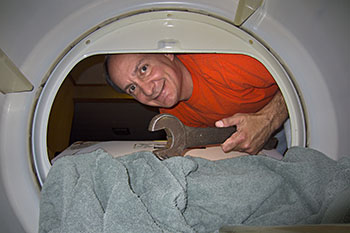
There are two groups of people: Those who break things, and those who fix them. Which one you belong to is dependent on the presence or absence of a special “Fix-it” gene in your DNA. The carrier of this gene feels an obligation to fix everything in sight that’s broken, and eventually becomes the go-to person in the family for repairs. I’m quite sure it was my grandfather who passed the gene down to me.
In his early twenties, my grandfather didn’t know how to hold a hammer. However, only a short time later, he was building his own home, opening up a repair shop in town, and once in an emergency, even filling his own tooth. My family and I were always amazed at his ability to fix anything. Looking back today, I find this even more impressive. He didn’t have the Internet to access step-by-step repair guides on websites and YouTube videos, nor could he go online and order just about any part he needed. Instead, he opened things up to figure out how they worked and how to fix them. When he repaired something, it was almost always stronger than it was before it had broken. He used excessive force to test his repairs no matter how small, putting all his weight on it or pulling it apart with all his might to try to break it again. If he fixed a cracked shoehorn, you could probably pry a door open with it.
My training began during childhood by observing my grandfather make repairs for my family. As I got older, I followed his example to disassemble and inspect whatever had broken and quickly learned that some repairs are often very simple. Yet, the assumption is always that they are difficult and time-consuming. So, if you fix something for another person without disclosing what you actually did, you’re likely to be hailed as some sort of superhero for just tightening a screw or changing a battery.
The rewards for making repairs include the obvious satisfaction of saving money and time, and helping out family members and friends. My grandfather found additional rewards for his repair skills during World War II. During that time when new bicycles were scarce, he supplemented his income by repairing and selling them from his garage and was well-known throughout the area. The way he fixed things, I’d bet some of those bicycles are still around today.  That was a time when everything was built to last and could be repaired if necessary. The cheaply-built products of today have short lives and are meant to be thrown away and replaced. Manufacturers often even go to great lengths to prevent their products from being disassembled and repaired. For me, that provides an additional source of satisfaction when I can “stick it to the man” by fixing something that wasn’t designed to be repaired. As an example of how times had changed, my grandfather spoke about how older cars like his were so much easier to work on than the newer models which are so packed in. He’d pop open the hood of his 1965 Chevy Chevelle, and point out how much empty space there was around the engine. “You could dance around in there,” he’d always say.
That was a time when everything was built to last and could be repaired if necessary. The cheaply-built products of today have short lives and are meant to be thrown away and replaced. Manufacturers often even go to great lengths to prevent their products from being disassembled and repaired. For me, that provides an additional source of satisfaction when I can “stick it to the man” by fixing something that wasn’t designed to be repaired. As an example of how times had changed, my grandfather spoke about how older cars like his were so much easier to work on than the newer models which are so packed in. He’d pop open the hood of his 1965 Chevy Chevelle, and point out how much empty space there was around the engine. “You could dance around in there,” he’d always say.
I learned early on that most repairs rarely go quickly and smoothly. Unlike home improvement shows on television, in the real world, walls are uneven, parts go missing or break, and frequent, repeated trips to the hardware store are necessary. I’ve been to my local Home Depot so often on a given day that I expect to be offered having an aisle in the store named after me, along with a plaque and dedication ceremony. What should be a five-minute project can easily turn into an all-day affair. Just the act of visiting a hardware store can be a challenge in itself. Although the big box stores like Home Depot and Lowes carry huge inventories, the item I’m shopping for always seems to be out of stock. That could be because these stores are geared more toward contractors and not the little guy like me who sometimes just needs a handful of small screws or a pack of batteries. Their shelves are fully stocked with giant nuts and bolts the size of an arm. I’ll keep that in mind the next time I’m building a skyscraper.
For those smaller items, I’ve had much better luck at the local Mom and Pop hardware store. They’re much more likely to have what I need if I don’t mind paying double the normal price and tolerating an overly helpful employee clung to me nonstop from the moment I walk in the store. I’ve noticed another advantage of the Mom and Pop is the likelihood of finding items that have long been discontinued, or banned by the government. If you’re in the market for some DDT, your corner hardware store just might have it sitting on a shelf and caked in an inch of dust.
My repair skill level increased over the years with much experience. Becoming a homeowner certainly provided me with endless opportunities to sharpen my skills on microwave ovens, computers, dishwashers, washing machines, etc. There’s seldom a delay between one thing breaking down and the next.
With that experience I’ve found that a certain amount of self-discipline is required. It’s easy to lose sight of the big picture and get carried away for hours repairing an item like a manual can opener that could be cheaply replaced for a few dollars. Without self-discipline, a collection of tools and spare parts can quickly grow out of control and overtake an entire basement. However, if you maintain control you’ll inevitably be put to the test when you finally discard an unused part you’ve held onto for ten years and then ending up needing it a week later.
 My grandfather lived long enough to watch me begin to become skilled at repairing. As he aged, I was grateful I had the opportunity to make some repairs for him and my grandmother but it paled in comparison to all those he had done for our family throughout his life. Every so often, when I see the evidence of his repair work still around in something at my mother’s house, I’m reminded of him. That has made me realize that fixing things is a way your mark gets left behind, and if you test them using all of your weight, probably for many years to come.
My grandfather lived long enough to watch me begin to become skilled at repairing. As he aged, I was grateful I had the opportunity to make some repairs for him and my grandmother but it paled in comparison to all those he had done for our family throughout his life. Every so often, when I see the evidence of his repair work still around in something at my mother’s house, I’m reminded of him. That has made me realize that fixing things is a way your mark gets left behind, and if you test them using all of your weight, probably for many years to come.
For related, more serious information on repairing, read an article about the Right to Repair legislation that is in the works.
This post was updated on June 28, 2017.





